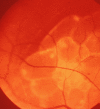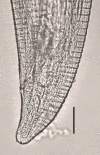Zoonotic helminths affecting the human eye
- PMID: 21429191
- PMCID: PMC3071329
- DOI: 10.1186/1756-3305-4-41
Zoonotic helminths affecting the human eye
Abstract
Nowaday, zoonoses are an important cause of human parasitic diseases worldwide and a major threat to the socio-economic development, mainly in developing countries. Importantly, zoonotic helminths that affect human eyes (HIE) may cause blindness with severe socio-economic consequences to human communities. These infections include nematodes, cestodes and trematodes, which may be transmitted by vectors (dirofilariasis, onchocerciasis, thelaziasis), food consumption (sparganosis, trichinellosis) and those acquired indirectly from the environment (ascariasis, echinococcosis, fascioliasis). Adult and/or larval stages of HIE may localize into human ocular tissues externally (i.e., lachrymal glands, eyelids, conjunctival sacs) or into the ocular globe (i.e., intravitreous retina, anterior and or posterior chamber) causing symptoms due to the parasitic localization in the eyes or to the immune reaction they elicit in the host. Unfortunately, data on HIE are scant and mostly limited to case reports from different countries. The biology and epidemiology of the most frequently reported HIE are discussed as well as clinical description of the diseases, diagnostic considerations and video clips on their presentation and surgical treatment.
Figures











References
-
- Williams RA, Brody BL, Thomas RG, Kaplan RM, Brown SI. The psychosocial impact of macular degeneration. Arch Ophthalmol. 1998;116:514–520. - PubMed
-
- Blindness and poverty. http://webadmin.hollows.org/Assets/Files/Blindness%20and%20Poverty%5B1%5...
-
- World Health Organization 2003. Onchocerciasis. http://www.who.int/blindness/partnerships/onchocerciasis_home/en/index.html
-
- Ryan E, Durrand M. In: Tropical Infectious Diseases Principals, Pathogens, and Practices. 2. Guerrant RL, WalkerDH, Weller PF, editor. Philadelphia: Churchill Livingstone; 2005. Ocular Disease; pp. 1554–1600.
Publication types
MeSH terms
LinkOut - more resources
Full Text Sources
Medical

